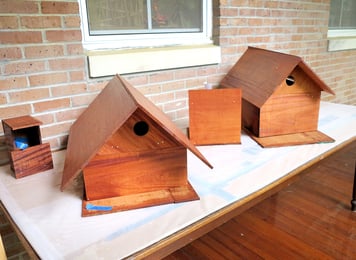
A platform that encourages healthy conversation, spiritual support, growth and fellowship

NOLACatholic Parenting Podcast
A natural progression of our weekly column in the Clarion Herald and blog

The best in Catholic news and inspiration - wherever you are!
Songbirds’ return among the goals of Academy of the Sacred Heart project
-
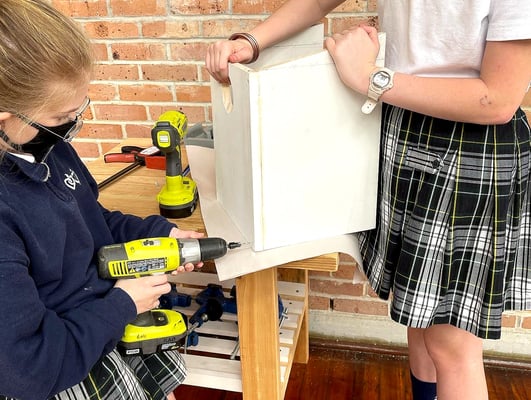
Above: Academy of the Sacred Heart sixth graders made prototypes of their assigned birdhouses and nesting boxes in their iLab before executing their final creations. (Photos courtesy of Academy of the Sacred Heart and by Beth Donze, Clarion Herald)
By BETH DONZE
Clarion Herald
When Hurricane Katrina ravaged New Orleans back in 2005, more than just the visual landscape took a hit. Months after the storm, an eerie quiet also hung over the barren city, in part, because the songbirds had left town to find food and adequate nesting places.
In a bid to assist the creatures’ ongoing return to our area, this year’s 32 sixth graders at the Academy of the Sacred Heart researched 12 native songbirds and built wooden homes tailored to the specific nesting needs of each.
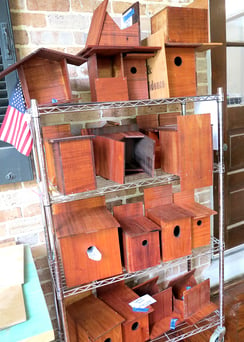
“Blue jays don’t need our help. Cardinals don’t need our help. That is why the girls focused on the birds that are still returning, that need help,” said Sacred Heart social studies teacher Sheila David, whose sixth graders probed the nesting preferences of local songbirds such as the Great Crested Flycatcher, Mourning Dove, Carolina Wren, Barn Swallow and Carolina Chickadee.The resulting avian homes are being auctioned off this month to benefit the class’ “Hearts for Humanity” project, whose fundraising goal of $1,800 will purchase five fresh water storage tanks for the Navajo Nation in New Mexico through the non-profit H2O for Life.
The sixth graders’ custom-built structures fall into two main design categories: “nesting boxes,” featuring a roof, three walls, an open-air facade and a nesting floor; and fully enclosed birdhouses, with circular or oval cut-outs giving the residents access to warmth and safety.
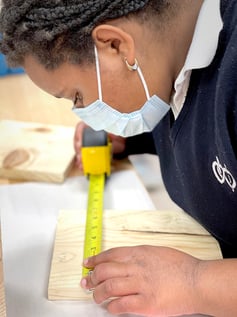 While researching the Tufted Titmouse, Ellie Brennan learned that her assigned songbird preferred to raise its chicks in small nesting boxes
While researching the Tufted Titmouse, Ellie Brennan learned that her assigned songbird preferred to raise its chicks in small nesting boxes measuring about 11 inches tall and 9 inches wide. She was intrigued by her bird’s nests of leaves, moss, grass and bark strips bound together with hair, wool and cloth.
“It is really cool how they construct their nests by layering certain materials,” Ellie said.
To protect the Tufted Titmouse from its predators – racoons, cats and snakes – the nesting box must be kept five to 15 feet above the ground and be sheltered from the wind, Ellie said.
“I hope they migrate back to Louisiana,” she said.
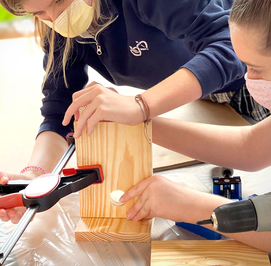 Kate Mogabgab learned that birdhouses used by the Eastern Bluebird ideally should have a protective shield called a “baffle” to ward off larger birds, squirrels, cats, fire ants and rats. Otherwise, Kate said her bird was good to go, needing only insects to thrive.
Kate Mogabgab learned that birdhouses used by the Eastern Bluebird ideally should have a protective shield called a “baffle” to ward off larger birds, squirrels, cats, fire ants and rats. Otherwise, Kate said her bird was good to go, needing only insects to thrive.“It’s a very chill bird,” Kate said. “This project really put me more in tune with knowing different types of birds.”
Although standard looking, lots of academics and elbow grease went into the creations. The need for precise measurements called on the sixth graders’ knowledge of fractions, and the students used drills, screws, glue and vises to join their wooden walls (because they are still too young to use the electric saws, wood was cut for them by iLab staff).
The young engineers first made a prototype of their design out of less expensive pine before building their final products out of donated mahogany. Finishing touches included using non-toxic linseed oil to bring out the mahoghany’s reddish-brown hue.
Three of the native songbirds required more expansive quarters: the American Kestrel, Northern Flicker and Purple Martin. The latter was researched by Charlotte Jenkins.
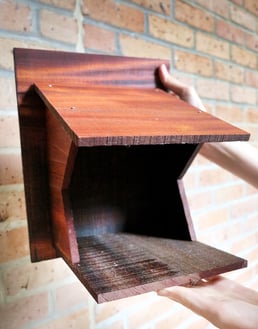 “Purple Martins have reall
“Purple Martins have reall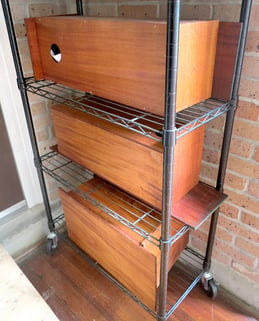 y big houses – they usually live in a condo-type birdhouse with a bunch of other birds,” Charlotte said.
y big houses – they usually live in a condo-type birdhouse with a bunch of other birds,” Charlotte said.Since 2015, David’s sixth-grade classes have cumulatively raised $7,700 for H2O for Life – for the drilling of water wells in Sudan – through their sale of handmade items such as soap, pottery and jewelry. This year, the class‘ focus is more local, with students learning about the water needs of indigenous peoples of the United States on their tribal lands.
“You wouldn’t think that in a developed country such as the United States that there would be people who do not have access to fresh water,” David said, ”but there are.”
Visit the live auction site at https://one.bidpal.net/ASHHeartsforHumanity/welcome.
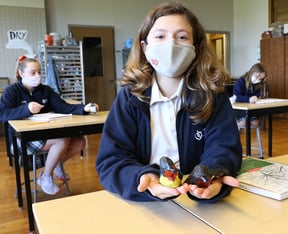
PIctured at right: The sixth graders made papier-mache sculptures of their assigned songbird in art to auction off with their birdhouses and nesting boxes.
